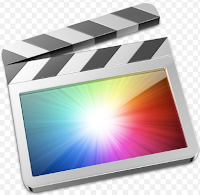As the film has begun to take place, we have realised that the script we previously had was simply not enough. We wanted to make the dialogue as interesting and informative as possible ad so we looked at different literary references. One poem that we found very striking was 'Aubade' by Philip Larkin. The stanza below stood out in particular. The plan would be to have this right at the beginning before the story kicks in as an intro/ prologue.

These few lines in particular:
"...No sight, no sound,
No touch or taste or smell, nothing to think with,
Nothing to love or link with,
The anasthetic from which none come round."
Below is the very final version of the script:
FADE IN - EXT.
Dylan, a young man of 19 years old and wearing dark clothes stands on the shore of a deserted, isolated beach. The sky is grey and the waves are calm. He looks out to the sea with an expression of desolate hope.
An internal monologue (VOICEOVER)
Montage one:
(with building intensity throughout)
It's been one hundred and nineteen days since I last saw another human being...
Sometimes I wonder if this is just a nightmare that I’m forgetting to wake up from… Or maybe I’m in a coma and unconscious to the world around me. I feel lonely and I feel scared. Maybe that’s a blessing because I used to feel nothing. Once upon a time, I had a family. People said we were the perfect family. I remember my mother and father. I remember playing out in the garden with my older brother in Summer. We were young. The warmth from the sun soothing our skin. The smell of freshly cut grass and the vivid colours swirling around us. I remember our brightly illustrated books and comics. They gave us the belief that we were invincible. I think that’s as close as you can get to pure happiness.
Montage two
I should probably introduce myself now. My name is Dylan and I am Nineteen. I’ve never been very good at the whole social convention thing. You see, at the age of thirteen I was diagnosed with schizophrenia. My parents passed away in a fatal accident which I don’t want to talk much about. Firstly, I suffered from PTSD and then it developed into something completely different. I completely lost control of my own head. By then, my brother was eighteen. He had to leave school, abandon his hopes of a normal life and take care of me. He did a great job, considering what a burden I was. I was going to university in September to study astronomy and I could even stretch so far as to say, the future was looking bright. I had a girlfriend. She made me feel something. Love? I’m not sure it was that, but it was something. I told her I loved her and I felt like a fraud. I just couldn’t keep it together and I wrecked it like everything else in my life. I felt distant and thought I didn’t need her anymore. Never ever lose sight of the important things in life…
Montage Three
***’Nothing Can fear a thing it will not feel, not seeing
That this is what we fear - No sight, No sound,
No touch or taste or smell, nothing to think with,
Nothing to love or link with
the anaesthetic from which none come round.’
Hindsight is a funny thing and somehow, no matter how much control I clawed back from my schizophrenia, I was fighting a losing battle. And so, I left. Ignoring everything my heart was telling me and fully submitting to my head. Everything went grey and I lost sight of what I had. The schizophrenia came back with a vengeance and the more I suppressed it, the more my head contorted. I was paranoid and couldn’t silence my thoughts. All I could think was death would be easier and no one would even care. Selfish old me. I think of how I felt back then and that was easy in comparison to this. This Hell… This middle ground… This purgatory.
What’s really strange is that I find things long lost from throughout my life. Memories wash up on the shore of this abyss like pieces of puzzle that I’m supposed to connect together. Am I supposed to make some kind of self discovery to buy me a ticket out of here? Some kind of realization to get me out of this prison world?…When I first came here, I liked being alone, the peace, the solitude. Eventually I became confused about what was happening as a thousand rational and irrational thoughts flew through my head. Did anyone know I was here? After a while, it didn’t matter what this was but I couldn’t handle it. I was sinking deeper and deeper every single day. My chest confined like the waves above it, unable to breathe or reason. Then it became clear to me that I didn’t get out of the bath I took four months ago. That I had taken too many of my meds that night….
Montage four
(Whispers) This is my afterlife.


 Recording the voiceover was the last task we had before making the final touches to the film. This was because we wanted to have the shots all taken and edited correctly so that we would know exactly how long he would need to all for and the different start and stop times in the voiceover. This meant that once it was done everything would be together. By shooting and editing everything first and leaving the voiceover to last, our group made the process of editing much more simple.
Recording the voiceover was the last task we had before making the final touches to the film. This was because we wanted to have the shots all taken and edited correctly so that we would know exactly how long he would need to all for and the different start and stop times in the voiceover. This meant that once it was done everything would be together. By shooting and editing everything first and leaving the voiceover to last, our group made the process of editing much more simple. On Final Cut, the whole process is pretty easy. You just go to colour correction and decide which hue, exposure and saturation levels you want. Below is an example of my colour chart. After this, you can make one colour grade the dominant by copying and pasting attributes to other clips then just varying little bits as and when necessary.
On Final Cut, the whole process is pretty easy. You just go to colour correction and decide which hue, exposure and saturation levels you want. Below is an example of my colour chart. After this, you can make one colour grade the dominant by copying and pasting attributes to other clips then just varying little bits as and when necessary. We used Final Cut Pro X to edit. At the very start of the editing process, we took all of our original footage and pieced it together to make a working and continuous story. Then we used the 'blade' tool (shortcut CMD, SHIFT KEY, B) to fine-tune each individual piece of footage so it connected. We removed all the audio and put it to 0 DB in preparation for the voiceover and atmosphere tracks which would be taken from foley, free sound.org and also, from imovie effects.
We used Final Cut Pro X to edit. At the very start of the editing process, we took all of our original footage and pieced it together to make a working and continuous story. Then we used the 'blade' tool (shortcut CMD, SHIFT KEY, B) to fine-tune each individual piece of footage so it connected. We removed all the audio and put it to 0 DB in preparation for the voiceover and atmosphere tracks which would be taken from foley, free sound.org and also, from imovie effects.
 The title helps to give some background information to the audience as well as making them question what is happening throughout the film. Also, it creates enigma in line with Barthe's Enigma code.
The title helps to give some background information to the audience as well as making them question what is happening throughout the film. Also, it creates enigma in line with Barthe's Enigma code.



 To show I have thought in depth about production, I decided to make my own 'ident'. After my post on choosing a sufficient distribution company for the film 'Unknown', it became clear that after the main funding film companies' ident there are lots of smaller production companies. The first Media Studies project that we did was a titling project called 'The Witch project', we became immersed in the project creating a production company named 'Bronze age Productions'. This year, I decided to change it up a bit and go for 'Bronze Age Vintage'. I felt that it really fitted in with the idea of colour burn flashbacks and the colour grade looked like a vintage french film. Below are the steps of how I made it and the indents:
To show I have thought in depth about production, I decided to make my own 'ident'. After my post on choosing a sufficient distribution company for the film 'Unknown', it became clear that after the main funding film companies' ident there are lots of smaller production companies. The first Media Studies project that we did was a titling project called 'The Witch project', we became immersed in the project creating a production company named 'Bronze age Productions'. This year, I decided to change it up a bit and go for 'Bronze Age Vintage'. I felt that it really fitted in with the idea of colour burn flashbacks and the colour grade looked like a vintage french film. Below are the steps of how I made it and the indents:


